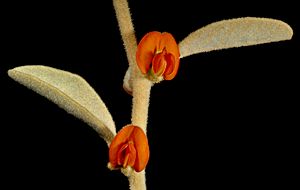Tephrosia arenicola facts for kids
Quick facts for kids Tephrosia arenicola |
|
|---|---|
 |
|
| Scientific classification | |
| Genus: |
Tephrosia
|
| Species: |
arenicola
|
The Tephrosia arenicola is a special plant that grows in the northern parts of Western Australia. It belongs to the Fabaceae family, which is also known as the pea or bean family. This plant is a type of shrub, and it was first described in 1980 by a scientist named John Richard Maconochie.
Contents
Discovering the Tephrosia arenicola
What Does This Plant Look Like?
The Tephrosia arenicola is a small shrub, usually growing up to about 50 centimeters (20 inches) tall. It has many stems that grow from its base. A cool thing about this plant is that it's covered in thick, tangled hairs. This makes it feel soft, almost like velvet!
Leaves and Flowers of the Shrub
Its leaves are quite unique. Even though they look like single leaves, they are actually a special type of compound leaf. They are shaped like an oval or an egg, and their edges are smooth. These leaves also have those soft, tangled hairs, and you can see about 6 to 8 small veins on their underside.
The flowers of the Tephrosia arenicola are small, about 5 to 6 millimeters long. They grow directly from where the leaves meet the stem. Each flower is a beautiful mix of orange and yellow. The main petal, called the "standard," is round and mostly orange, but it has a bright yellow spot at its center, like an "eye." The other petals, called "wings" and "keel," are also orange.
When Does Tephrosia arenicola Bloom?
This plant shows off its lovely flowers during the autumn months. You can usually see it blooming from April to May in Western Australia.
Where Does Tephrosia arenicola Grow?
Its Natural Home in Western Australia
The Tephrosia arenicola is found in several different areas across Western Australia. These areas include the Central Kimberley, the Gascoyne, the Gibson Desert, the Great Sandy Desert, the Little Sandy Desert, and the Pilbara.
Preferred Growing Spots
This plant likes to grow in sandy places. You can find it on wide, flat sandplains, along sand ridges, and even in areas where water usually flows, called drainage lines. It grows well in red sand, sandy gravel, and a type of soil called alluvium, which is made of sand and silt carried by water.
Protecting Tephrosia arenicola
Its Conservation Status
Good news for the Tephrosia arenicola! In Western Australia, this plant is considered "not threatened." This means that there are enough of these plants in the wild, and they are not currently at risk of disappearing.

